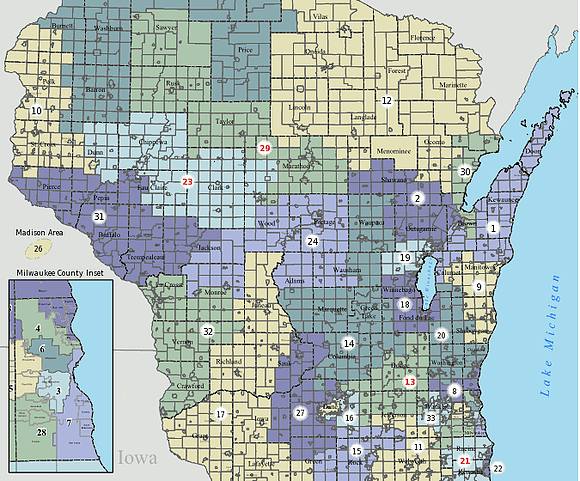Wisconsin Federal Court Accepts New Gerrymander Standard
On Monday, November 21, a panel of three federal judges determined that the Wisconsin Legislature’s 2011 redrawing of State Assembly districts was an unconstitutional partisan gerrymander.
Past legal challenges to maps drawn to benefit one party over another had been dismissed. As the Supreme Court majority wrote in Vieth v. Jubelirer in 2004, without “judicially discernible and manageable standards,” courts had no basis for evaluating political advantage in litigated maps.
In 2014 political scientists Nicholas Stephanopoulos and Eric McGhee addressed this lack with a suggested standard called the “efficiency gap.” Stephanopoulos summarized it this way in an article explaining potential application:
The efficiency gap is simply the difference between the parties’ respective wasted votes in an election, divided by the total number of votes cast. Wasted votes are ballots that don’t contribute to victory for candidates, and they come in two forms: lost votes cast for candidates who are defeated, and surplus votes cast for winning candidates but in excess of what they needed to prevail. When a party gerrymanders a state, it tries to maximize the wasted votes for the opposing party while minimizing its own, thus producing a large efficiency gap. In a state with perfect partisan symmetry, both parties would have the same number of wasted votes.
In Whitford v. Nichol, plaintiffs used the efficiency gap to show that district lines for Wisconsin’s State Assembly had been drawn to disadvantage Democratic voters.
Two of the three judges agreed with their conclusions. As the New York Times explained:
“Although Wisconsin’s natural political geography plays some role in the apportionment process,” the court wrote, “it simply does not explain adequately the sizable disparate effect” of Republican gains in the State Assembly after the boundaries were redrawn.
“Several election-law scholars said the ruling was especially significant because it offered, for the first time, a clear mathematical formula for measuring partisanship in a district, something that had been missing in previous assaults on gerrymandering.”
According to Stephanopoulos, “Pennsylvania was one of seven large states with pro-Republican efficiency gaps of at least two seats in 2012.” (Others were Florida, Michigan, North Carolina, Ohio, Texas, and Virginia.)
If Wisconsin appeals this decision, the case will move to the Supreme Court, with far-reaching implications. With some of the most gerrymandered districts in the county and a clear efficiency gap in our representation, Pennsylvania will be watching closely.
You can read the full decision here.
